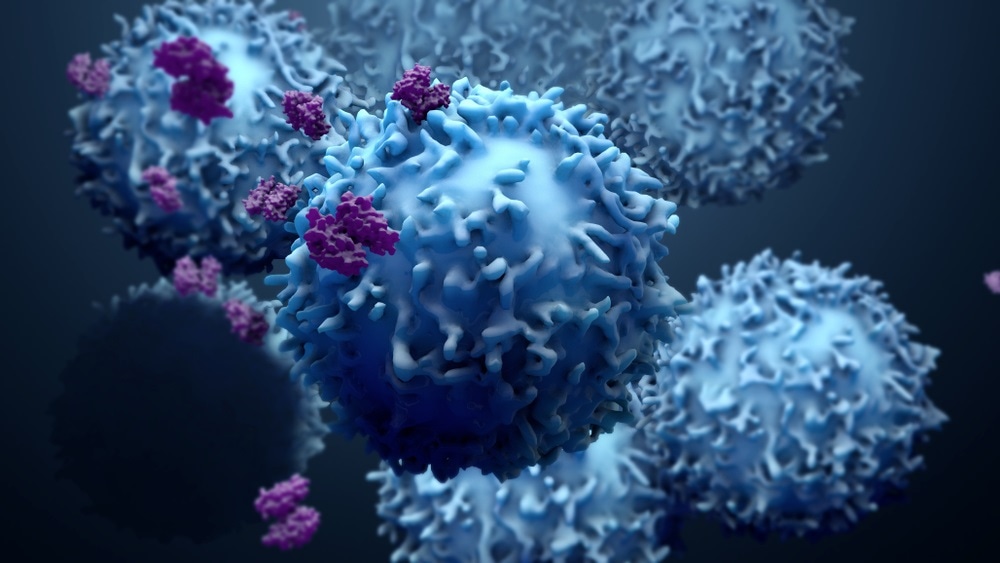Researchers have made an important discovery about a molecule called EGR4 (early growth response protein) that could pave the way for a new immunotherapy approach to treating cancer.
 Image Credits: Design_Cells / Shutterstock.com
Image Credits: Design_Cells / Shutterstock.com
The therapy would involve removing the transcription factor EGR4 from a patient’s T cells and then infusing them back into the patient’s body – an approach that the researchers are calling “viable.”
Immune system “brakes”
The immune system continuously undergoes tight regulation, which involves what scientists refer to as immune system “brakes.” These brakes stop the immune system from overreacting to abnormal or invading agents so that inflammation does not become excessive enough to damage healthy tissues.
However, in cases of cancer, this “damage limitation” system is very susceptible to being harnessed by tumor cells in a way that is advantageous to them. The tumor cells can inhibit these immune system brakes, which enables them to escape detection and avoid immune system targeting and attack.
Researchers have discovered several naturally occurring immune system brakes, which has offered promise in the field of immunotherapy, where the immune system is harnessed to target and kill cancer cells.
However, further research is still needed to understand more about the factors that drive cancer immunity, if immunotherapy is going to work as a treatment for people.
EGR4 is a crucial immune system brake
Now, Jonathan Soboloff from the Lewis Katz School of Medicine at Temple University (LKSOM) and colleagues have demonstrated in the first study of its kind that EGR4, which has so far primarily been understood as a contributor to male infertility, actually functions as an important immune system brake.
As recently described in the journal EMBO Reports, the researchers found that eliminating EGR4 from immune cells (and effectively taking the foot off the brake) induces the activity of killer T cells, which target and attack cancer cells and effectively boost anticancer activity.
Soboloff, a professor of medical genetics and molecular biochemistry at LKSOM says that other EGRs are known to be involved in prompting T cell activity, but until now, little has been understood about the role EGR4 may play.
“While the zinc finger transcription factors EGR1, EGR2, and EGR3 are recognized as critical for T‐cell function, the role of EGR4 remains unstudied,” write Soboloff and colleagues. “Here, we show that EGR4 is rapidly upregulated upon TCR [T cell receptor]engagement, serving as a critical “brake” on T‐cell activation.”
Soboloff says the research “reveals a new side to the importance of EGR4."
What did the study involve?
For the study, Soboloff’s team worked with Dietmar Kappes, professor of blood cell development and cancer at Fox Chase Cancer Center to investigate the effect that EGR4 expression has on immune cells.
First, the researchers discovered that there was a link between the activation of T cells and the upregulation of EGR4. Next, they demonstrated that when EGR4 is removed or “knocked out” from immune cells, calcium signaling significantly increases and T helper type (Th1) cell populations expand.
The role of Th1 cells is to respond to invading or foreign cells, including cancer cells, by inducing the activity of killer T cells. These killer T cells then target, infiltrate and destroy tumor cells.
"We know from our previous work that T cells control calcium signaling and that when intracellular calcium levels are elevated, calcium signaling can drive T cell activation."
Jonathan Soboloff, Lewis Katz School of Medicine at Temple University
Next, the researchers investigated the functional role of EGR4 in protecting against cancer using a mouse model of melanoma, where some of the animals had EGR4 knocked out.
Compared with mice that had normal EGR4 expression, Th1 populations were expanded in the knockout mice and these animals exhibited evidence of increased immunity to cancer. More specifically, the mice without EGR4 had less lung tumor burden and fewer cases of cancer that had metastasized compared with mice that had not had EGR4 knocked out.
More details about the knockout mice
“TCR engagement of EGR4−/− [knockout]T cells leads to enhanced Ca2+ responses, driving sustained NFAT [Nuclear factor of activated T-cells] activation and hyperproliferation,” explains the team. “This causes profound increases in IFNγ production under resting and diverse polarizing conditions that could be reversed by pharmacological attenuation of Ca2+ entry.”
In the future, the researchers would like to investigate ways of targeting EGR4. Kappes says that while the multiple actions of EGRs may make it difficult to develop a drug that can target EGR4 specifically, “eliminating EGR4 specifically from a patient's T cells, and then putting those cells back into the patient, may be a viable immunotherapeutic approach.”
Source:
Brake on immune activity identified, raising new possibilities for anticancer therapy. EurekAlert! 2020. Available at: https://www.embopress.org/doi/10.15252/embr.201948904
Journal reference:
Soboloff J, et al. Suppression of Ca2+ signals by EGR4 controls Th1 differentiation and anti‐cancer immunity in vivo. EMBO Reports 2020. https://doi.org/10.15252/embr.201948904